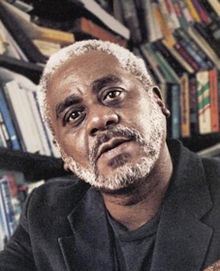ZEN IRODALOM ZEN LITERATURE
« Zen index
« Home

Charles Richard Johnson (1948-)
https://en.wikipedia.org/wiki/Charles_R._Johnson
PDF: Turning the wheel: essays on Buddhism and writing
by Charles Johnson
Scribner, 2003, pp. 22-25.
One of the perennially enchanting documents of Ch'an
(Zen) Buddhism is the "Ten Oxherding Pictures," which
inspired my second novel, Oxherding Tale (1982). These drawings
depict the spiritual stages of Zen development that lead to
enlightenment by portraying the search of a young herdsman
for his lost ox (self). Each illustration is followed by commentary
in prose and verse. The ten stages shown are (1) Seeking
the Ox; (2) Finding the Tracks; (3) First Glimpse of the Ox; (4)
Catching the Ox; (5) Taming the Ox; (6) Riding the Ox Home;
(7) Ox Forgotten, Self Alone; (8) Both Ox and Self Forgotten;
(9) Returning to the Source; and (10) Entering the Marketplace
with Helping Hands. It is this final panel that speaks significantly
to the question of Perfect Conduct.The version of the Oxherding Pictures important for this
discussion was created in 1150 C.E. by Zen master K'uo-an
Shih-yuan (Kakuan Shien in Japanese). Some earlier versions of
the Oxherding Pictures offered only five or eight drawings, usually
ending with an empty circle (Both Ox and Self Forgotten) ,
which fit nicely the arhat ideal of Theravada Buddhism. "This
implied," says Philip Kapleau, "that the realization of Oneness
(i.e., the effacement of every conception of self and other) was
the ultimate goal of Zen. But Kakuan, feeling this to be incomplete,
added two more pictures beyond the circle to make it clear
that the Zen man of the highest spiritual development lives in
the mundane world of form and diversity' and mingles with the
utmost freedom among ordinary men, whom he inspires with
his compassion and radiance to walk in the Way of the Buddha."
Shih-yuan's final, tenth picture is accompanied by this
commentary:10 / Entering the Marketplace with Helping Hands /
The gate of his cottage is closed and even the wisest cannot
find him. His mental panorama has finally disappeared. He
goes his own way, making no attempt to follow the steps of
earlier sages. Carrying a gourd, he strolls into the market;
leaning on his staff, he returns home. He leads innkeepers
and fishmongers in the Way of the Buddha.Kapleau's gloss on the commentary of this tenth image deserves
examination:In ancient China gourds were commonly used as wine bottles.
What is implied here therefore is that the man of the
deepest spirituality is not adverse to drinking with those
fond of liquor in order to help them overcome their delusion.
... In Mahayana Buddhism . . . the man of deep
enlightenment (who may be and often is the layman) gives
off no 'smell' of enlightenment, no aura of 'saintliness'; if he
did, his spiritual attainments would be regarded as still
deficient. Nor does he hold himself aloof from the evils of
the world. He immerses himself in them whenever necessary
to emancipate men from their follies, but without
being sullied by them himself. In this he is like the lotus, the
symbol in Buddhism of purity and perfection, which grows
in mud yet is undefiled by it.Often we hear that the attainment of Oneness, or being
awakened, is "nothing much" (for the belief in separateness was
a chimera in the first place). Like Bunan, the Oxherder discovers
that "The moon's the same old moon / The flowers
exactly as they were." He will take a drink. And perhaps eat
meat. But to none of this is he attached. Nor does he crave them.
Like the abbot I met in Thailand, he does not fret about "good"
or "bad" karma, because in his conduct all he is capable of are
acts in accordance with ahimsa, which he does not name or
judge as "good," no more than the lotus bothers to name the
natural act of its efflorescence. And the Oxherder has a sense of
humor and irony. How could he not? He knows that, despite all
he has attained through a lifetime of practice, he is still an
embodied being and, as such, will experience until the day of his
death a residual stain of dualism, a tincture of samsara, and
traces of suffering, which he recognizes when they arise in his
consciousness. All that he "lets go," and when he dies, falling like
a raindrop back into the sea, it is unlikely he will return (or
return too often) on the Wheel of remanifestation. He is, in a
sense, a refugee—homeless and groundless. He watches the
ceaseless play of his thoughts, but is not naive enough to believe
there is a thinker. (For a Buddhist, Descartes asserted but he did
not prove his claim "I think, therefore I am," because all that one
can empirically verify is that "There is thinking going on.") He
is alone with others who are also refugees or tourists with no
solid basis for security, and nothing permanent in this world. He
pilgrimages through the Marketplace (the realm that turns on
four, dualistic pairs of opposites: "getting and losing, disrepute
and fame, blame and praise, happiness and suffering") with
fearlessness, probity, desirelessness (nishpriha), transcendent
joy, and he delights in the suchness of everyday things:How wonderful, how marvelous!!
I fetch wood, I carry water!To the innkeepers and fishmongers, the Oxherder appears,
in one sense, as nothing special, with no sanctimonious stink of
self-righteousness on him since all sentient beings have Buddha-nature
and dwell in "an inescapable network of mutuality." But
through his example—his compassion toward all beings, his
gentle speech, and his unshakable peace and happiness—he
points them toward their own possibilities.
PDF: Oxherding Tale (novel, 1982)